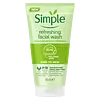What's inside
What's inside
 Key Ingredients
Key Ingredients

No key ingredients
 Benefits
Benefits

 Concerns
Concerns

 Ingredients Side-by-side
Ingredients Side-by-side

Water
Skin ConditioningDicaprylyl Carbonate
EmollientCaprylic/Capric Triglyceride
MaskingGlycerin
HumectantPropanediol
SolventC14-22 Alcohols
Emulsion StabilisingPolysorbate 60
EmulsifyingC12-20 Alkyl Glucoside
EmulsifyingParfum
MaskingSodium Citrate
BufferingPolyacrylate Crosspolymer-6
Emulsion StabilisingCaprylyl Glycol
EmollientCitric Acid
BufferingDisodium EDTA
Ethylhexylglycerin
Skin ConditioningXanthan Gum
EmulsifyingMelissa Officinalis Leaf Extract
Skin ConditioningT-Butyl Alcohol
PerfumingGentiana Lutea Extract
EmollientMaltodextrin
AbsorbentMoringa Oleifera Seed Extract
Skin ConditioningWater, Dicaprylyl Carbonate, Caprylic/Capric Triglyceride, Glycerin, Propanediol, C14-22 Alcohols, Polysorbate 60, C12-20 Alkyl Glucoside, Parfum, Sodium Citrate, Polyacrylate Crosspolymer-6, Caprylyl Glycol, Citric Acid, Disodium EDTA, Ethylhexylglycerin, Xanthan Gum, Melissa Officinalis Leaf Extract, T-Butyl Alcohol, Gentiana Lutea Extract, Maltodextrin, Moringa Oleifera Seed Extract
 Reviews
Reviews

Ingredients Explained
These ingredients are found in both products.
Ingredients higher up in an ingredient list are typically present in a larger amount.
Citric Acid is an alpha hydroxy acid (AHA) naturally found in citrus fruits like oranges, lemons, and limes.
Like other AHAs, citric acid can exfoliate skin by breaking down the bonds that hold dead skin cells together. This helps reveal smoother and brighter skin underneath.
However, this exfoliating effect only happens at high concentrations (20%) which can be hard to find in cosmetic products.
Due to this, citric acid is usually included in small amounts as a pH adjuster. This helps keep products slightly more acidic and compatible with skin's natural pH.
In skincare formulas, citric acid can:
While it can provide some skin benefits, research shows lactic acid and glycolic acid are generally more effective and less irritating exfoliants.
Most citric acid used in skincare today is made by fermenting sugars (usually from molasses). This synthetic version is identical to the natural citrus form but easier to stabilize and use in formulations.
Read more about some other popular AHA's here:
Learn more about Citric AcidDisodium EDTA plays a role in making products more stable by aiding other preservatives.
It is a chelating agent, meaning it neutralizes metal ions that may be found in a product.
Disodium EDTA is a salt of edetic acid and is found to be safe in cosmetic ingredients.
Learn more about Disodium EDTAGlycerin is already naturally found in your skin. It helps moisturize and protect your skin.
A study from 2016 found glycerin to be more effective as a humectant than AHAs and hyaluronic acid.
As a humectant, it helps the skin stay hydrated by pulling moisture to your skin. The low molecular weight of glycerin allows it to pull moisture into the deeper layers of your skin.
Hydrated skin improves your skin barrier; Your skin barrier helps protect against irritants and bacteria.
Glycerin has also been found to have antimicrobial and antiviral properties. Due to these properties, glycerin is often used in wound and burn treatments.
In cosmetics, glycerin is usually derived from plants such as soybean or palm. However, it can also be sourced from animals, such as tallow or animal fat.
This ingredient is organic, colorless, odorless, and non-toxic.
Glycerin is the name for this ingredient in American English. British English uses Glycerol/Glycerine.
Learn more about GlycerinWater. It's the most common cosmetic ingredient of all. You'll usually see it at the top of ingredient lists, meaning that it makes up the largest part of the product.
So why is it so popular? Water most often acts as a solvent - this means that it helps dissolve other ingredients into the formulation.
You'll also recognize water as that liquid we all need to stay alive. If you see this, drink a glass of water. Stay hydrated!
Learn more about Water